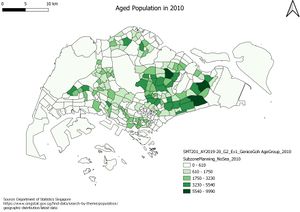Difference between revisions of "SMT201 AY2019-20T1 EX1 Goh Jia Xin Genice"
Jump to navigation
Jump to search
| Line 3: | Line 3: | ||
== Part 2: Chloropeth Mapping == | == Part 2: Chloropeth Mapping == | ||
| − | === Aged Population (65+) in 2010=== | + | === Aged Population (65+) in 2010 and 2018=== |
| − | [[File:Aged65 2010.jpg|thumb]] | + | [[File:Aged65 2010.jpg|thumb|left]] |
| − | |||
| − | |||
| − | |||
| − | |||
=== Aged Population (65+) in 2018=== | === Aged Population (65+) in 2018=== | ||
Likewise, I extracted the 2018 Age Group Data from the master file ‘SGPopulationAgeGroupSex’ obtained from Data.gov.sg and cleaned it. I joined the cleaned data with the 2014 Subzone Planning Map and created a new variable called Aged65+, which calculates the number of Singapore Residents who are aged 65 and above. Afterwards, I used graduated categorisation using the variable Aged65+ to create this map. | Likewise, I extracted the 2018 Age Group Data from the master file ‘SGPopulationAgeGroupSex’ obtained from Data.gov.sg and cleaned it. I joined the cleaned data with the 2014 Subzone Planning Map and created a new variable called Aged65+, which calculates the number of Singapore Residents who are aged 65 and above. Afterwards, I used graduated categorisation using the variable Aged65+ to create this map. | ||
Revision as of 15:36, 15 September 2019
Contents
Part 1: Thematic Mapping
Part 2: Chloropeth Mapping
Aged Population (65+) in 2010 and 2018
Aged Population (65+) in 2018
Likewise, I extracted the 2018 Age Group Data from the master file ‘SGPopulationAgeGroupSex’ obtained from Data.gov.sg and cleaned it. I joined the cleaned data with the 2014 Subzone Planning Map and created a new variable called Aged65+, which calculates the number of Singapore Residents who are aged 65 and above. Afterwards, I used graduated categorisation using the variable Aged65+ to create this map.
